城市绿地规划复习资料
- 格式:doc
- 大小:40.00 KB
- 文档页数:3
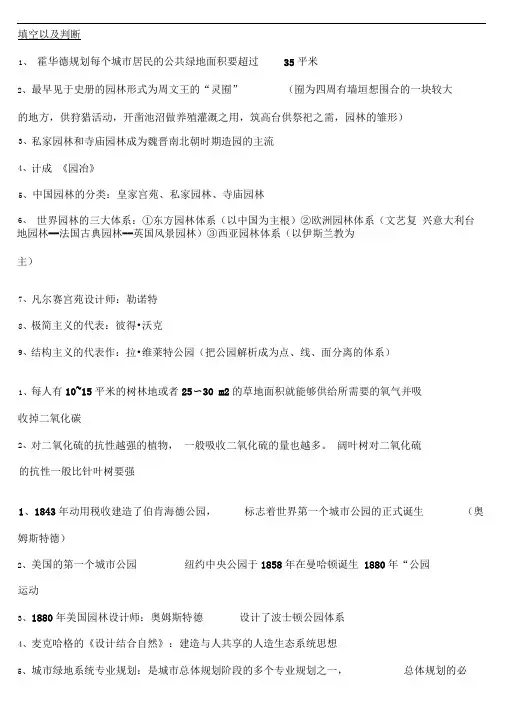
填空以及判断霍华德规划每个城市居民的公共绿地面积要超过 35平米2、最早见于史册的园林形式为周文王的“灵囿”(囿为四周有墙垣想围合的一块较大的地方,供狩猎活动,开凿池沼做养殖灌溉之用,筑高台供祭祀之需,园林的雏形)世界园林的三大体系:①东方园林体系(以中国为主根)②欧洲园林体系(文艺复 兴意大利台地园林--法国古典园林--英国风景园林)③西亚园林体系(以伊斯兰教为 主)1、 3、 私家园林和寺庙园林成为魏晋南北朝时期造园的主流 4、 计成 《园冶》5、 中国园林的分类:皇家宫苑、私家园林、寺庙园林6、 7、 凡尔赛宫苑设计师:勒诺特 8、 极简主义的代表:彼得•沃克9、 结构主义的代表作:拉•维莱特公园(把公园解析成为点、线、面分离的体系)1、 每人有10~15平米的树林地或者25〜30 m2的草地面积就能够供给所需要的氧气并吸收掉二氧化碳2、 对二氧化硫的抗性越强的植物, 一般吸收二氧化硫的量也越多。
阔叶树对二氧化硫的抗性一般比针叶树要强1、1843年动用税收建造了伯肯海德公园, 标志着世界第一个城市公园的正式诞生 (奥姆斯特德)2、美国的第一个城市公园纽约中央公园于1858年在曼哈顿诞生 1880年“公园运动3、1880年美国园林设计师:奥姆斯特德 设计了波士顿公园体系4、 麦克哈格的《设计结合自然》:建造与人共享的人造生态系统思想5、城市绿地系统专业规划:是城市总体规划阶段的多个专业规划之一, 总体规划的必要组成部分,该层次的规划主要涉及城市绿地在总体规划层次上的统筹安排。
城市绿地系统专项规划:(单独编制的专业规划)是对城市绿地系统专业规划的深 入和细化。
(是对城市各类绿地及物种在类型、规模、空间、时间等方面所进行的系统化配置及相关安排) 6、2002年,国家建设部颁布了《城市绿地分类标准》 产绿地G2防护绿地G3附属绿地G4其他绿地G5G1 :公园绿地、综合绿地、全市性公园、区域性公园、社区公园、居住区公园、 小区游园、专类公园、儿童公园、动物园、植物园、历史名园、风景名胜公园、游乐 公园、其他专类公园、带状公园、街旁绿地城市绿地率:城市建成区内绿化面积之和一城市用地面积城市绿地覆盖率:城市内全部绿化种植垂直投影面积一城市用地面积10、带状公园的宽度一般不小于8米11、在历史保护区、旧城改建区,街旁绿地面积要求不小于 1000平米,绿地占地比例 不小于65%防护绿地的种类:卫生隔离带、道路防护绿带、城市高压走廊绿带、防风林带13、道路绿地:包括道路绿带、行道树绿带、分车绿带、路侧绿带、交通岛绿地 14、红线宽度大于50米的道路绿地率不得小于 30%,红线宽度在40~50米的道路绿 地率不得小于25%,红线宽度小于40米的道路绿地率不得小于 20%15、古树:树龄在100年以上 名木:有重大意义《城市绿地系统规划》的规划成果包括:规划文本、规划说明书、规划图则、规 划基础资料分为五类:公园绿地 G1生7、 城市绿地三大指标:人均公园绿地面积、人均绿地面积、 城市绿地率8、 人均公园绿地面积(平方米 人):城市公园绿地面积G1 一城市人口数量 人均绿地面积:城市建成区内绿地面积之和一人口(G1、G2 G3 G4)服务半径居住区公园: 500~800 小区游园: 300~50012、 16、1、乔木:具有体形高大、主干明显、分支点高、寿命长的特点干,多成丛生状态或基部分枝2、植物生长的最佳温度:0〜29C 3、对植包括:对称种植、非对称种植 4、孤植:最适距离(最佳观察)为树高的四倍左右1、廊:空廊、水廊、半廊、复廊、双层廊、曲廊 P1352、建筑与水面配合方式:凌跨水上、紧临水边、建筑与水面之间设置平台过度3、园路的作用:组织交通、引导游览、组织空间、构成园景、为水电工程打下基础 4、园路类型:主要园路(最宽不能超过 6米)、次要园路(2-4米)、游憩小路(小于 2 米)园林的观景游憩需求使游览性成为矛盾的主要方面6、园路面积不应过大,控制在总面积的10% -12%7、雕塑分为:纪念性雕塑、主题性雕塑、装饰性雕塑9、景窗作用:连续布置可以对单调的墙面进行装饰点缀,使之产生有节奏的韵律感1、人的行为按社会特征分为:必要性行为、自主性行为(也称为选择性行为,在园林绿化规划设计中考虑最多的)、社会性行为1、人正常视距为25厘米,空间视距上限为 450-500米。
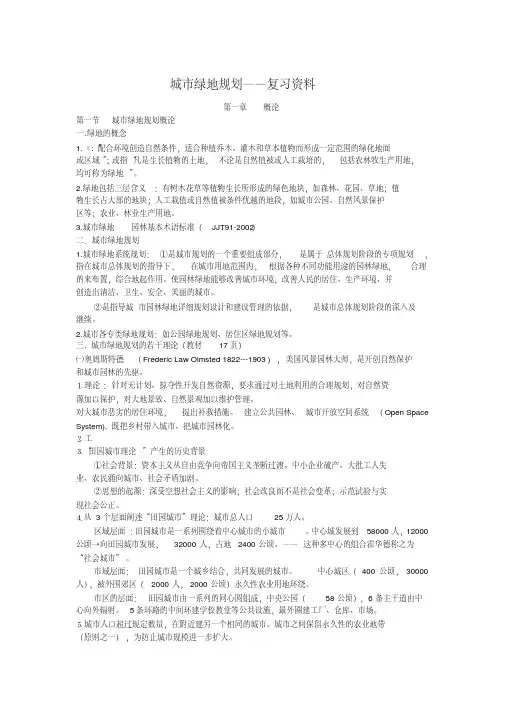
城市绿地规划——复习资料第一章概论第一节城市绿地规划概论一.绿地的概念1.《:“配合环境创造自然条件,适合种植乔木、灌木和草本植物而形成一定范围的绿化地面或区域”;或指“凡是生长植物的土地,不论是自然植被或人工栽培的,包括农林牧生产用地,均可称为绿地”。
2.绿地包括三层含义:有树木花草等植物生长所形成的绿色地块,如森林、花园、草地;植物生长占大部的地块;人工栽植或自然植被条件优越的地段,如城市公园、自然风景保护区等;农业、林业生产用地。
3.城市绿地园林基本术语标准(JJT91-2002)二.城市绿地规划1.城市绿地系统规划:①是城市规划的一个重要组成部分,是属于总体规划阶段的专项规划,指在城市总体规划的指导下,在城市用地范围内,根据各种不同功能用途的园林绿地,合理的来布置,综合地起作用。
使园林绿地能够改善城市环境,改善人民的居住、生产环境、并创造出清洁、卫生、安全、美丽的城市。
②是指导城市园林绿地详细规划设计和建设管理的依据,是城市总体规划阶段的深入及继续。
2.城市各专类绿地规划:如公园绿地规划、居住区绿地规划等。
三. 城市绿地规划的若干理论(教材17页)㈠奥姆斯特德(Frederic Law Olmsted 1822---1903 ) ,美国风景园林大师,是开创自然保护和城市园林的先驱。
⒈理论:针对无计划、掠夺性开发自然资源,要求通过对土地利用的合理规划,对自然资源加以保护,对大地景致、自然景观加以维护管理。
对大城市恶劣的居住环境,提出补救措施。
建立公共园林、城市开放空间系统(Open Space System), 既把乡村带入城市、把城市园林化。
⒉工⒊“田园城市理论”产生的历史背景①社会背景:资本主义从自由竞争向帝国主义垄断过渡。
中小企业破产、大批工人失业、农民涌向城市、社会矛盾加剧。
②思想的起源:深受空想社会主义的影响;社会改良而不是社会变革;示范试验与实现社会公正。
⒋从3个层面阐述“田园城市”理论:城市总人口25万人。
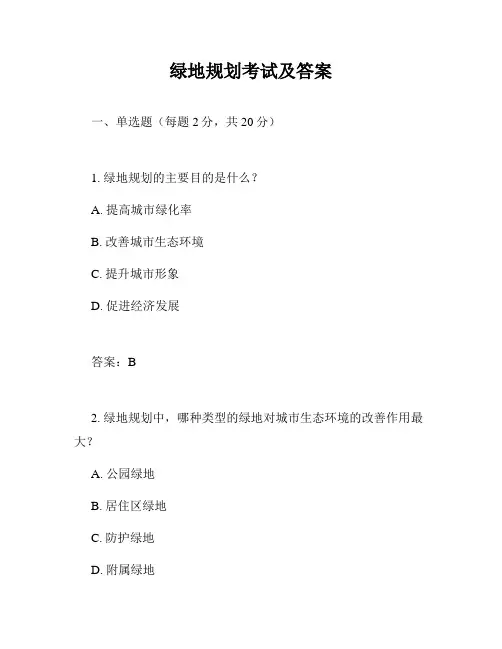
绿地规划考试及答案一、单选题(每题2分,共20分)1. 绿地规划的主要目的是什么?A. 提高城市绿化率B. 改善城市生态环境C. 提升城市形象D. 促进经济发展答案:B2. 绿地规划中,哪种类型的绿地对城市生态环境的改善作用最大?A. 公园绿地B. 居住区绿地C. 防护绿地D. 附属绿地答案:C3. 绿地规划中,公园绿地的面积一般占城市建设用地的多少比例?A. 5%-10%B. 10%-15%C. 15%-20%D. 20%-25%答案:B4. 绿地规划中,防护绿地的主要功能是什么?A. 休闲娱乐B. 环境保护C. 交通疏导D. 城市美化答案:B5. 绿地规划中,附属绿地的主要作用是什么?A. 提供休闲娱乐场所B. 改善城市生态环境C. 提升城市形象D. 促进经济发展答案:B6. 绿地规划中,居住区绿地的面积一般占居住区用地的多少比例?A. 10%-15%B. 15%-20%C. 20%-25%D. 25%-30%答案:C7. 绿地规划中,城市道路绿化带的宽度一般是多少?A. 1-2米B. 2-3米C. 3-4米D. 4-5米答案:B8. 绿地规划中,城市广场绿地的面积一般占广场用地的多少比例?A. 20%-30%B. 30%-40%C. 40%-50%D. 50%-60%答案:C9. 绿地规划中,水体绿化的主要作用是什么?A. 提供休闲娱乐场所B. 改善城市生态环境C. 提升城市形象D. 促进经济发展答案:B10. 绿地规划中,城市绿化覆盖率一般要求达到多少?A. 30%-40%B. 40%-50%C. 50%-60%D. 60%-70%答案:B二、多选题(每题3分,共15分)11. 绿地规划中,公园绿地的主要类型包括哪些?A. 城市公园B. 社区公园C. 郊野公园D. 儿童公园答案:ABCD12. 绿地规划中,防护绿地的主要类型包括哪些?A. 道路防护绿地B. 水体防护绿地C. 工业防护绿地D. 居住区防护绿地答案:ABCD13. 绿地规划中,附属绿地的主要类型包括哪些?A. 居住区附属绿地B. 工业区附属绿地C. 商业区附属绿地D. 办公区附属绿地答案:ABCD14. 绿地规划中,城市道路绿化带的主要类型包括哪些?A. 行道树B. 中央隔离带C. 两侧绿化带D. 人行道绿化答案:ABCD15. 绿地规划中,城市广场绿地的主要类型包括哪些?A. 中心广场绿地B. 街心广场绿地C. 商业广场绿地D. 文化广场绿地答案:ABCD三、判断题(每题1分,共10分)16. 绿地规划的主要目的是提高城市绿化率。
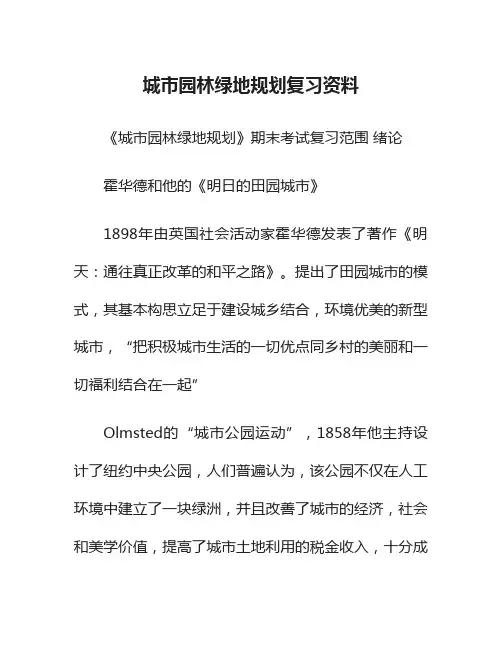
城市园林绿地规划复习资料 《城市园林绿地规划》期末考试复习范围 绪论 霍华德和他的《明日的田园城市》 1898年由英国社会活动家霍华德发表了著作《明天:通往真正改革的和平之路》。提出了田园城市的模式,其基本构思立足于建设城乡结合,环境优美的新型城市,“把积极城市生活的一切优点同乡村的美丽和一切福利结合在一起”
Olmsted的“城市公园运动”,1858年他主持设计了纽约中央公园,人们普遍认为,该公园不仅在人工环境中建立了一块绿洲,并且改善了城市的经济,社会和美学价值,提高了城市土地利用的税金收入,十分成功。随机纷纷效仿,掀起建设公园的“城市公园运动” 计成的《园冶》;
中国(1631)古代造园专著,也是中国第一本园林艺术理论的专著。 英国伦敦的“绿带政策”
1988年,英国政府颁布了绿带规划政策指引PPG2,详细规定了绿带的作用,土地用途,边界划分和开发控制要求等内容。 绿色基础设施;
绿色基础设施是指一个相互联系的绿色空间网络,由各种开敞空间和自然区域组成,包括绿道、湿地、雨水花园、森林、乡土植被等,这些要素组成一个相互联系、有机统一的网络系统。 风景园林
在一定的区域内运用工程技术和艺术手段,通过改造地形,种植花草 树木,营造建筑和布�Z园路等途径创作而成的美的自然环境和游憩区域。 open space的含义; 是在城市的建筑实体以外存在的开敞空间体,是人与社会与自然进行信息、物质和能量交换的重要场所,它包括山林农田、河湖水体、各种绿地等的自然空间,以及城市的广场、道路、庭院等的自然与非自然空间。
北京、杭州、苏州的著名传统园林及其特征; 北京、北京颐和园。杭州、西湖十景。苏州苏州拙政园 特征;1、天人合一的自然崇拜2、仿自然山水格局的景观类型3、诗情画意的表现手法4、舒适宜人的人居环境5、巧于因借的视阈扩展6、循序渐进的空间序列7、小中见大的视觉效果8、委婉含蓄的情感表达
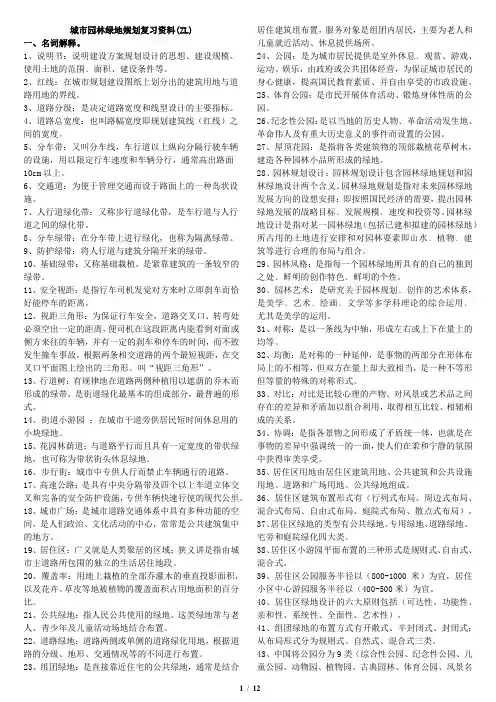
城市园林绿地规划复习资料(ZL)一、名词解释。
1、说明书:说明建设方案规划设计的思想、建设规模、使用土地的范围﹑面积、建设条件等。
2、红线:在城市规划建设图纸上划分出的建筑用地与道路用地的界线。
3、道路分级:是决定道路宽度和线型设计的主要指标。
4、道路总宽度:也叫路幅宽度即规划建筑线(红线)之间的宽度。
5、分车带:又叫分车线,车行道以上纵向分隔行驶车辆的设施,用以限定行车速度和车辆分行,通常高出路面10cm以上。
6、交通道:为便于管理交通而设于路面上的一种岛状设施。
7、人行道绿化带:又称步行道绿化带,是车行道与人行道之间的绿化带。
8、分车绿带:在分车带上进行绿化,也称为隔离绿带。
9、防护绿带:将人行道与建筑分隔开来的绿带。
10、基础绿带:又称基础栽植,是紧靠建筑的一条较窄的绿带。
11、安全视距:是指行车司机发觉对方来时立即刹车而恰好能停车的距离。
12、视距三角形:为保证行车安全,道路交叉口、转弯处必须空出一定的距离,便司机在这段距离内能看到对面或侧方来往的车辆,并有一定的刹车和停车的时间,而不致发生撞车事故。
根据两条相交道路的两个最短视距,在交叉口平面图上绘出的三角形。
叫“视距三角形”。
13、行道树:有规律地在道路两侧种植用以遮荫的乔木而形成的绿带,是街道绿化最基本的组成部分,最普遍的形式。
14、街道小游园;在城市干道旁供居民短时间休息用的小块绿地。
15、花园林荫道:与道路平行而且具有一定宽度的带状绿地,也可称为带状街头休息绿地。
16、步行街:城市中专供人行而禁止车辆通行的道路。
17、高速公路;是具有中央分隔带及四个以上车道立体交叉和完备的安全防护设施,专供车辆快速行使的现代公里。
18、城市广场:是城市道路交通体系中具有多种功能的空间,是人们政治、文化活动的中心,常常是公共建筑集中的地方。
19、居住区:广义就是人类聚居的区域;狭义讲是指由城市主道路所包围的独立的生活居住地段。
20、覆盖率:用地上栽植的全部乔灌木的垂直投影面积,以及花卉、草皮等地被植物的覆盖面积占用地面积的百分比。
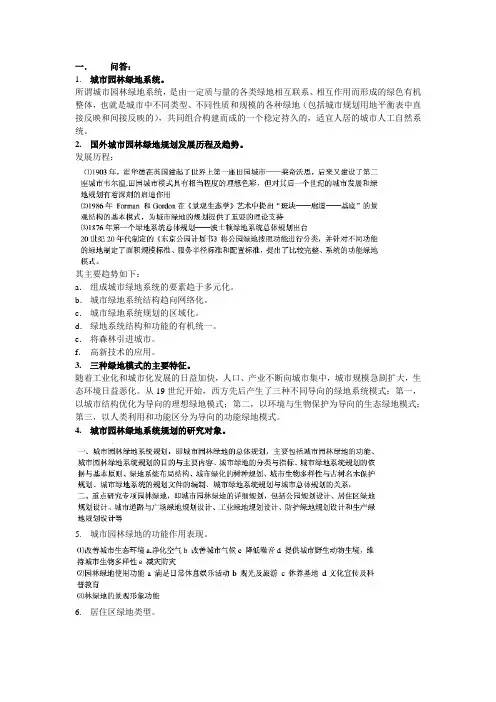
一.问答:1.城市园林绿地系统。
所谓城市园林绿地系统,是由一定质与量的各类绿地相互联系、相互作用而形成的绿色有机整体,也就是城市中不同类型、不同性质和规模的各种绿地(包括城市规划用地平衡表中直接反映和间接反映的),共同组合构建而成的一个稳定持久的,适宜人居的城市人工自然系统。
2.国外城市园林绿地规划发展历程及趋势。
发展历程:其主要趋势如下:a.组成城市绿地系统的要素趋于多元化。
b.城市绿地系统结构趋向网络化。
c.城市绿地系统规划的区域化。
d.绿地系统结构和功能的有机统一。
e.将森林引进城市。
f.高新技术的应用。
3.三种绿地模式的主要特征。
随着工业化和城市化发展的日益加快,人口、产业不断向城市集中,城市规模急剧扩大,生态环境日益恶化。
从19世纪开始,西方先后产生了三种不同导向的绿地系统模式:第一,以城市结构优化为导向的理想绿地模式;第二,以环境与生物保护为导向的生态绿地模式;第三,以人类利用和功能区分为导向的功能绿地模式。
4.城市园林绿地系统规划的研究对象。
5.城市园林绿地的功能作用表现。
6.居住区绿地类型。
7.园林苗圃用地选择的条件。
8.根据高速公路防护画出高速功能断面示意图。
9.简述城市园林绿地系统规划内容。
10.城市公园游人的容量确定并用公式表示。
二.名词解释。
三.论述。
1.防护绿地的作用。
2.环境有污染的车间的绿化设计要考虑的问题及解决方法。
3.城市道路绿化种植的形式及特点。
4.大学入口处绿地功能作用和设计要点。
5.综合性公园中如何进行功能分区和景色分区。
6.城市园林绿地生物多样性保护与建设规划。
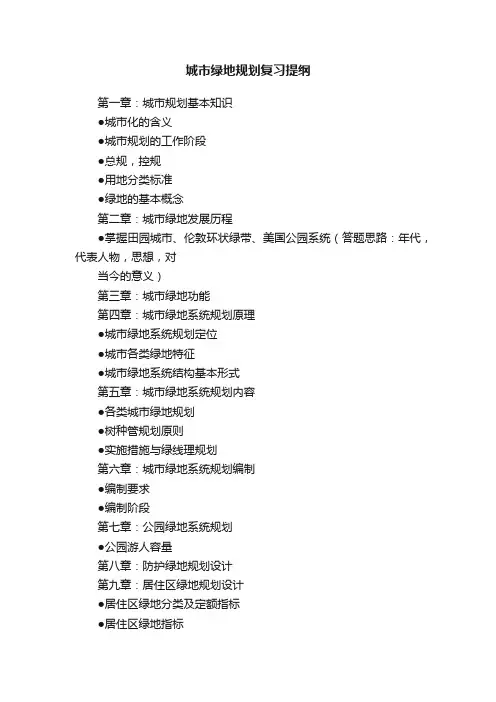
城市绿地规划复习提纲第一章:城市规划基本知识●城市化的含义●城市规划的工作阶段●总规,控规●用地分类标准●绿地的基本概念第二章:城市绿地发展历程●掌握田园城市、伦敦环状绿带、美国公园系统(答题思路:年代,代表人物,思想,对当今的意义)第三章:城市绿地功能第四章:城市绿地系统规划原理●城市绿地系统规划定位●城市各类绿地特征●城市绿地系统结构基本形式第五章:城市绿地系统规划内容●各类城市绿地规划●树种管规划原则●实施措施与绿线理规划第六章:城市绿地系统规划编制●编制要求●编制阶段第七章:公园绿地系统规划●公园游人容量第八章:防护绿地规划设计第九章:居住区绿地规划设计●居住区绿地分类及定额指标●居住区绿地指标●居住区绿地与居住绿地的相关性分析●各类绿地的布局要求第十二章:道路绿地规划设计●道路绿地的组成●道路绿地率●道路绿地的断面布置形式附录二:城市绿地系统规划编制纲要第一章:城市规划基本知识●城市化的含义1.城市化含义:城市化即农业人口及农用土地向非农业人口和城市用地转化的现象和过程,又称城镇化。
2.城市化特征:A.人口职业转变:由农业转为第二三产业,表现为农业人口不断减少,非农业人口不断增加B.产业结构转变:第二三产业比重提高,第一产业比重下降;农业生产现代化;农村多余人口转向城市第二三产业C.土地及地域空间的变化:农业用地转化为非农业用地,由比较分散、低密度的居住形式转变为集中成片、密度较高的居住形式;由与自然环境接近的空间转变为以人工环境为主的空间城市化水平=城镇人口/总人口× 100%●城市规划基本理论1.城市规划的任务:城市规划是人类为了在城市的发展中维持公共生活的空间秩序而做的未来空间安排。
本质上来讲,城市规划是人居环境各层面上的以城市层次为工作对象的空间划分。
2.城市总体规划:对一定时期内城市性质、发展目标、发展规模、土地利用、空间布局以及各项建设的综合部署和实施措施。
3.控制性详细规划:主要以对地块的用地使用控制和环境容量控制、建筑建造控制和城市设计引导、市政工程设施和公共服务设施的配套、交通活动控制和环境保护规定为主要内容。
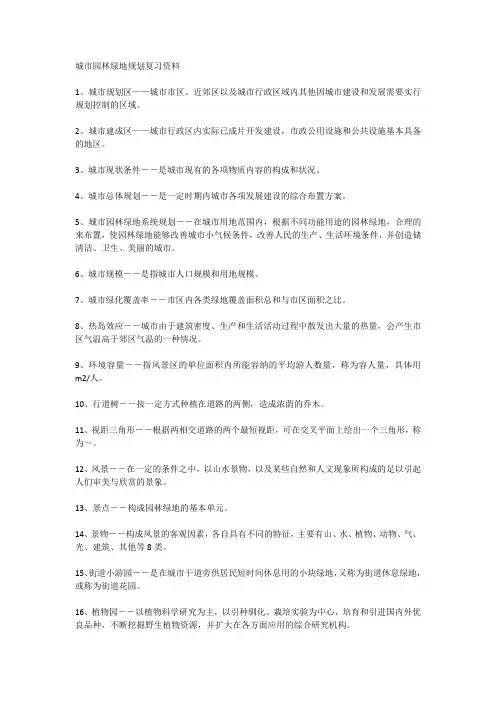
城市园林绿地规划复习资料1、城市规划区——城市市区、近郊区以及城市行政区域内其他因城市建设和发展需要实行规划控制的区域。
2、城市建成区——城市行政区内实际已成片开发建设,市政公用设施和公共设施基本具备的地区。
3、城市现状条件――是城市现有的各项物质内容的构成和状况。
4、城市总体规划――是一定时期内城市各项发展建设的综合布置方案。
5、城市园林绿地系统规划――在城市用地范围内,根据不同功能用途的园林绿地,合理的来布置,使园林绿地能够改善城市小气候条件,改善人民的生产、生活环境条件,并创造储清洁、卫生、美丽的城市。
6、城市规模――是指城市人口规模和用地规模。
7、城市绿化覆盖率――市区内各类绿地覆盖面积总和与市区面积之比。
8、热岛效应――城市由于建筑密度、生产和生活活动过程中散发出大量的热量,会产生市区气温高于郊区气温的一种情况。
9、环境容量――指风景区的单位面积内所能容纳的平均游人数量,称为容人量,具体用m2/人。
10、行道树――按一定方式种植在道路的两侧,造成浓荫的乔木。
11、视距三角形――根据两相交道路的两个最短视距,可在交叉平面上绘出一个三角形,称为~。
12、风景――在一定的条件之中,以山水景物,以及某些自然和人文现象所构成的足以引起人们审美与欣赏的景象。
13、景点――构成园林绿地的基本单元。
14、景物――构成风景的客观因素,各自具有不同的特征,主要有山、水、植物、动物、气、光、建筑、其他等8类。
15、街道小游园――是在城市干道旁供居民短时间休息用的小块绿地,又称为街道休息绿地,或称为街道花园。
16、植物园――以植物科学研究为主,以引种驯化、栽培实验为中心,培育和引进国内外优良品种,不断挖掘野生植物资源,并扩大在各方面应用的综合研究机构。
17、自净作用――少量污染物一时性进入环境中,经过各种自然过程而分解、稀释,仍可使环境保持并恢复到原来的状态,生态平衡不致破坏。
18、“邻里单位”是城市居住区规划中的一种结构形式,1929年由美国人佩里提出。
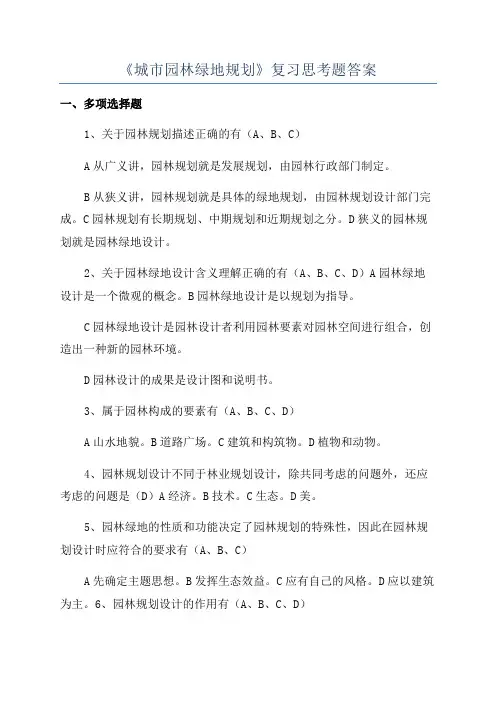
《城市园林绿地规划》复习思考题答案一、多项选择题1、关于园林规划描述正确的有(A、B、C)A从广义讲,园林规划就是发展规划,由园林行政部门制定。
B从狭义讲,园林规划就是具体的绿地规划,由园林规划设计部门完成。
C园林规划有长期规划、中期规划和近期规划之分。
D狭义的园林规划就是园林绿地设计。
2、关于园林绿地设计含义理解正确的有(A、B、C、D)A园林绿地设计是一个微观的概念。
B园林绿地设计是以规划为指导。
C园林绿地设计是园林设计者利用园林要素对园林空间进行组合,创造出一种新的园林环境。
D园林设计的成果是设计图和说明书。
3、属于园林构成的要素有(A、B、C、D)A山水地貌。
B道路广场。
C建筑和构筑物。
D植物和动物。
4、园林规划设计不同于林业规划设计,除共同考虑的问题外,还应考虑的问题是(D)A经济。
B技术。
C生态。
D美。
5、园林绿地的性质和功能决定了园林规划的特殊性,因此在园林规划设计时应符合的要求有(A、B、C)A先确定主题思想。
B发挥生态效益。
C应有自己的风格。
D应以建筑为主。
6、园林规划设计的作用有(A、B、C、D)A保证城市园林绿地的发展和巩固。
B是上级主管部门批准园林绿地建设费用的依据。
C园林绿地施工的依据。
D园林绿地建设检查验收的依据。
7、园林规划设计的依据有(A、B、C、D)A科学依据。
B社会需要。
C功能要求。
D经济条件。
8、园林设计的适用原则所包含的意思有(A、B)A因地制宜,B功能适合于服务对象。
C美观。
D个性化。
9、关于园林规划设计原则描述正确的有(A、C、D)A适用、经济、美观是园林设计的基本原则。
B美观是设计首要考虑的问题。
C适用、经济、美观三者之间是辩证统一的。
D在适用、经济的前提下,尽可能做到美观。
10、关于园林美描述正确的有(A、B、C、D)A园林美是自然景观和人文景观的高度统一。
B园林美是形式美与内容美的高度统一。
C园林美是自然美、生活美、艺术美的高度统一。
D园林美源于自然,又高于自然景观。
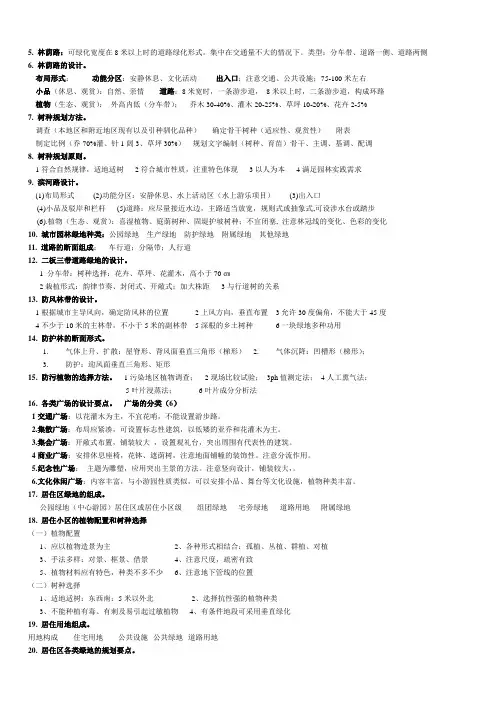
5. 林荫路:可绿化宽度在8米以上时的道路绿化形式。
集中在交通量不大的情况下。
类型:分车带、道路一侧、道路两侧6. 林荫路的设计。
布局形式:功能分区:安静休息、文化活动出入口:注意交通、公共设施;75-100米左右小品(休息、观赏):自然、亲情道路:8米宽时,一条游步道,8米以上时,二条游步道,构成环路植物(生态、观赏):外高内低(分车带);乔木30-40%、灌木20-25%、草坪10-20%、花卉2-5%7. 树种规划方法。
调查(本地区和附近地区现有以及引种驯化品种)确定骨干树种(适应性、观赏性)附表制定比例(乔70%灌、针1阔3、草坪30%)规划文字编制(树种、育苗)骨干、主调、基调、配调8. 树种规划原则。
1符合自然规律,适地适树2符合城市性质,注重特色体现3以人为本4满足园林实践需求9. 滨河路设计。
(1)布局形式(2)功能分区:安静休息、水上活动区(水上游乐项目)(3)出入口(4)小品及驳岸和栏杆(5)道路:应尽量接近水边,主路适当放宽,规则式或抽象式,可设涉水台或踏步(6).植物(生态、观赏):喜湿植物、庭荫树种、固堤护坡树种;不宜闭塞, 注意林冠线的变化、色彩的变化10. 城市园林绿地种类:公园绿地生产绿地防护绿地附属绿地其他绿地11. 道路的断面组成:车行道;分隔带;人行道12. 二板三带道路绿地的设计。
1 分车带:树种选择:花卉、草坪、花灌木,高小于70㎝2栽植形式:韵律节奏、封闭式、开敞式;加大株距3与行道树的关系13. 防风林带的设计。
1根据城市主导风向,确定防风林的位置2上风方向,垂直布置3允许30度偏角,不能大于45度4不少于10米的主林带,不小于5米的副林带5深根的乡土树种6一块绿地多种功用14. 防护林的断面形式。
1. 气体上升、扩散:屋脊形、背风面垂直三角形(梯形)2. 气体沉降:凹槽形(梯形);3. 防护:迎风面垂直三角形、矩形15. 防污植物的选择方法。
1污染地区植物调查;2现场比较试验;3ph值测定法;4人工熏气法;5叶片浸蒸法;6叶片成分分析法16. 各类广场的设计要点。
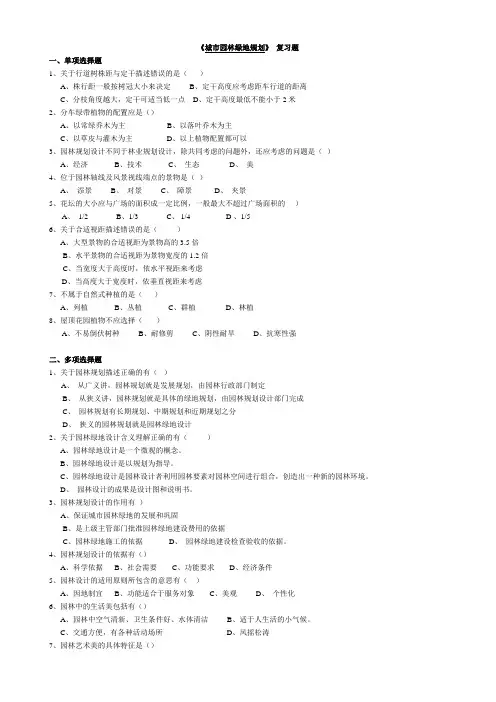
《城市园林绿地规划》复习题一、单项选择题1、关于行道树株距与定干描述错误的是()A、株行距一般按树冠大小来决定B、定干高度应考虑距车行道的距离C、分枝角度越大,定干可适当低一点D、定干高度最低不能小于2米2、分车绿带植物的配置应是()A、以常绿乔木为主B、以落叶乔木为主C、以草皮与灌木为主D、以上植物配置都可以3、园林规划设计不同于林业规划设计,除共同考虑的问题外,还应考虑的问题是()A、经济B、技术C、生态D、美4、位于园林轴线及风景视线端点的景物是()A、添景B、对景C、障景D、夹景5、花坛的大小应与广场的面积成一定比例,一般最大不超过广场面积的)A、1/2B、1/3C、 1/4 D 、1/56、关于合适视距描述错误的是()A、大型景物的合适视距为景物高的3.5倍B、水平景物的合适视距为景物宽度的1.2倍C、当宽度大于高度时,依水平视距来考虑D、当高度大于宽度时,依垂直视距来考虑7、不属于自然式种植的是()A、列植B、丛植C、群植D、林植8、屋顶花园植物不应选择()A、不易倒伏树种B、耐修剪C、阴性耐旱D、抗寒性强二、多项选择题1、关于园林规划描述正确的有()A、从广义讲,园林规划就是发展规划,由园林行政部门制定B、从狭义讲,园林规划就是具体的绿地规划,由园林规划设计部门完成C、园林规划有长期规划、中期规划和近期规划之分D、狭义的园林规划就是园林绿地设计2、关于园林绿地设计含义理解正确的有()A、园林绿地设计是一个微观的概念。
B、园林绿地设计是以规划为指导。
C、园林绿地设计是园林设计者利用园林要素对园林空间进行组合,创造出一种新的园林环境。
D、园林设计的成果是设计图和说明书。
3、园林规划设计的作用有)A、保证城市园林绿地的发展和巩固B、是上级主管部门批准园林绿地建设费用的依据C、园林绿地施工的依据D、园林绿地建设检查验收的依据。
4、园林规划设计的依据有()A、科学依据B、社会需要C、功能要求D、经济条件5、园林设计的适用原则所包含的意思有()A、因地制宜B、功能适合于服务对象C、美观D、个性化6、园林中的生活美包括有()A、园林中空气清新、卫生条件好、水体清洁B、适于人生活的小气候。
城市园林绿地规划复习资料Review of urban garden and green space planning1,urban planning areas - urban areas, peri urban areas and other urban administrative areas for pla.rming and control of urban construetion and development needs of the region.2,the urban built-up area, which has actually been developed and built in the urban administrative area, has the basic areas of municipal, public facilities and public facilities・3,the status quo of the city 一the composition and condition of the existing material content of the city・4,the overall urban planning - is a period of urban development and construction of the integrated layout plan.5,the city green space system planning 一一in the city within the scope of land, according to the different functions of landscape, layout reasonable, the landscape can improve the city microclimate conditions, improving the environmental conditions of life and production of local people, and create the city clean and beautiful reservoir・6,urban scale 一refers to the size of urban population and land use scale・7,urban green coverage 一the total area of urban green space coverage and urban area ratio.8,the heat island effect, because the city density, production and life activities emit a large amount of heat, will produce urban temperaturehigher than the suburban temperature of a situation.9,environmental capacity -- that the average number of visitors to the scenic area per unit area can accommodate, called one volume, specific m2/・10,trees -- according to a certain way of planting on both sides of the road, causing the shade of trees・11,Los triangle - according to the two intersection of the two shortest sight distance, you can draw a triangle on the cross plane, called12,landscape - in certain conditions, with landscape features, as well as certain natural and human phenomena constituted enough to cause people to appreciate and appreciate the scene・13,attractions - constitute the basic unit of garden green space・14,scenery 一the objective factors that constitute the scenery, each has different characteristics, mainly mountains, water, plants, animals, gas, light, architecture, and other 8 categories・15,the street small garden -- is in the city tTimk road for residents short time to use the small green space, also known as street rest green, or called street garden.16,the botanical garden -- a study of plant science, the introduction and domestication, cultivation experiment center, training and the introduction of domestic and foreign varieties, constantly digging wild plant resources, and expand the comprehensive research institutions in all aspects of the application.17,self purification function - a small amount of pollutants temporarily into the environment, through a variety of natural processes and decomposition, dilution, still can make the environment to maintain and restore to the original state, the ecological balance will not be destroyed.18,''neighborhood unit" is a form of urban residential planning, in 1929 by the Americans Perry proposed.19,''garden city" was proposed by Howard, a British social activist in the late nineteenth Century, about urban planningIn the evaluation process of urban land suitability, the usual way is to divide the land into 3 types according to the advantages and disadvantages20,the overall urban planning period is generally 20 years21,agriculture, forestry, animal husbandry, fishery a nd water conservancy belong to the first industry in the industrial type. Industry belongs to the second industry in the industry type・Tourism belongs to the third industry in the urban industry type ・22,urbanization includes the change of population occupation, the change of industrial structure, the change of land and regional space and the perfection of infrastructure・23,the population size is classified, large cities (more than 1 million people), large cities (50^100 million), medium-sized cities (20〜50 million), small cities (less than 200 thousand people)24,in people,s psychological feelings, the most influential factors of urban impression include roads, boundaries, centers, regional features, markers・25,urban disaster prevention planning includes: urban flood control planning, urban fire protection planning, urban mitigation earthquake planning, urban people,s air defense planning・26,in the city overall planning of land use balance, residential land accounted for the city land accounted for 50% - 60%.In 27, the single city construction land, residential land use control in general each 18 〜28 square meters; industrial land is generally controlled at each 9 ~ 22 square meters: the road square for general control in each 8 〜15 square meters; green space per person shall not be less than 9 square meters・28,in the urban green space type, the urban construction land is not involved in the balance of residential green space and ancillary green space・29,our country city planning relevant standards: landscape road greening rate of not less than 40%; the line width of more than 50m of the road, green rate of not less than 30%; the red line width of 40m-50m Road, green rate of not less than 25%; the line width is less than 40m of the road, green rate of not less than 20%30,the most influential factors on urban impression include the following 5 parts: Road, boundary, center, region and marker・31,the preparation of urban planning is generally divided into overallplanning and detailed planning in 2 stages・32,the layout of urban green space should maintain the balance of urban ecological system・ The basic requirements include reasonable layout, advanced indexes, good quality and environmental improvement・33,The functions of urban green space include landscape function, culture and education function, recreation function, and improvement of urban ecological environment function.34,the urban ancient and famous trees protection planning content mainly involves: designated laws and regulations, publicity and education, scientific research, conservation management・35,the municipal comprehensive park service radius of 2000m, district level comprehensive park service radius of 1000m,community park service radius is generally 500m.36,the comprehensive park according to its activities can be divided into: cultural and recreational areas, ornamental tourist area, quiet rest area, children,s activities area, old age activity area, sports area, garden management area and service facilities・37,the basic unit of residential areas is residential areas38,the types of residential green space include: public green space, public facilities, green land, road green space, green space next to the house・39,the basic forms of residential garden design in the residential areaare regular, free and mixed.In the urban garden green space, the garden road is the skeleton of the small gardenLayout 40, road greening section: a two second, three belt belt, three four belt, belt type and the other four in five・41,in the trunk roads planted trees, dry height may not be less than 3. 5m; non motor vehicles and sidewalks between the roadside trees, dry height can not be less than 2. 5m, otherwise it will affect traffic and people,s access・42,the minimum spacing for 4m tree planting, fast-growing tree planting distance generally use 5 - 6m. Planting trees into tree and tree pool43,there are requirements for road slope, for motor vehicles, the road slope should not exceed 3 to 4%%・44,according to the status of the road in the city, traffic characteristics and functions, can be divided into different grades ・Big city, big city is generally divided into expressway, trunk road, secondary road and branch45,the central green belt of the highway is strictly prohibited to grow trees46,In urban street greening, its health protection functions include purifying air, reducing noise and reducing radiant heat.47,according to the function and nature of the city square, we can divide the urban square green space into: the meeting square, the memorial square, the traffic square, the commercial square, the cultural entertainment plaza・48,according to its function, the protection greenbelt can be divided into urban windbreak belt, health protection forest belt, soil and water conservation forest and farmland protection forest・49,the main functions of the green space include improving the natural conditions and sanitary conditions of the city50,factories and enterprises are mainly composed of: Factory front zone, production area, open-air dumping ground andwarehouse area, green and landscaping lots.51,the significance of plant greening is mainly as follows: conducive to environmental protection - functional value, conducive to the creation of spiritual wealth 一spiritual value, conducive to the creation of material wealth 一economic value・Including the basic principles, 52 factories and enterprises in the landscape plant selection: suitable tree species, and determine the backbone and key determine the rational proportion, meet the production process requirements on the environment, choose the easy reproduction, easy to manage・53,in the campus green space planning, 5 meters away from the building to plant trees54,scenic spots in the scenic tour of the organization process, the organization of tour procedures include: into the scene, launched, brewing, climax, end・55,the basic elements of the landscape are composed of 3 categories, namely scenery, scenery and conditions.Including 56, scenic resource evaluation: Jingyuan investigation, selection and classification, classification, evaluation and Jingyuan Jingyuan conclusion・57,brief description of the social city problems, mainly in what areas?・Answer: 1, residential issues 2, traffic problems 3, urban pollution problems 4, urban disaster 5, urban environmental landscape problems58,Briefly describe the main ways to protect the environment.Answer: 1. Measures should be taken to control pollution sources so as to reduce or eliminate pollution・2,reasonable planning layout・ 3, take biological measures, common greening, vigorously afforestation, planting grass and flowers・59,brief description of the layout of urban green spaceAnswer: 1, to meet the city's convenient cultural entertainment, leisure and sightseeing requirements・ 2, to meet the city life and safety requirements of production activities・3,to achieve a virtuous cycle of urban ecological environment and the harmonious development of human and nature・4, to meet the requirements of urban landscape art・60,brief description of the urban garden green space system layout principle.Answer: 1, the urban green space system planning should be combined with other parts of the city planning, comprehensive consideration, comprehensive arrangements・2,the urban green space system planning must be in accordance with local conditions and proceed from reality・3,urban park green space should be evenly distributed, reasonable service radius, to meet the needs of the city,s cultural rest・61.Briefly describe the basic principles for the classification of urban green space・Answer: 1, the function of the green space as the main classification basis・2,the classification of green space should be consistent with the calculation of urban planning land balance・3,the green space classification should strive to reflect the characteristics of different types of urban green space・4,the green space should try to consider the comparability with other countries in the world.5,in classification, we should consider the statistical range of green space, the sources of investment and management system・62,brief description of the city garden green space index basis.Answer: 1. The level of urban garden and green space in china・ 2, the level and trend of foreign urban green space・ 3, the requirements of environmental protection of urban ecology. 4, from sightseeing and cultural leisure need to consider・63.Briefly introduce the principles of urban greening plant planning ・Answer: 1. Respect for the law of natural development・ 2. Take the regional plant species as the main type; 3, select the resistant plants 4, and the fast-growing tree species with the slow tree species64,the basic principles of comprehensive park planning are briefly described・Answer: 1, the implementation of national policy in the construction of green spaces, policies and regulations, to comply with the relevant standards. To inherit and reform our gardening art system, we should absorb foreign advanced experience and create our own unique garden style and features2,take full account of the public use of the park requirements, rich Park activities and space types・3,local conditions, so that the park and local history, culture and natural features combine to reflect local characteristics and style4,make full use of the present situation and the natural terrain park, park organic elements, to play their proper role in different functional areas・5,the planning and design should be practical, and specify feasible construction plans and management measures at different stages・65,brief description of factories and enterprises greening features ・Answer: 1, poor environment is not conducive to plant growth,2,land use compact, green land area is small3,green to ensure the safety of the factory production, 4, factory green service object to the factory workers66,brief description of industrial and mining enterprises greening significance・Answer: 1, conducive to environmental protection 一functional value of 2, conducive to the creation of spiritual wealth - spiritual value of 3, conducive to the creation of material wealth - economic value67,brief description of the protection green space, according to its function can be divided into what kinds?・Answer: 1, the city windbreak belt・ 2. Sanitary protective belt. 3.Soil and water conservation forest・ 4, farmland shelterbelt・68,brief description of the role of urban green space protection.Answer: 1, windbreak sand fixing 2, reduce the content of carbon dioxide in the atmosphere 3, absorb harmful gas 4, cool, moisturizing 5, clean environment and beautify the city69,Brief description of the layout of road greening section.Answer: (1) a two second belt (2) with three (3) board with four (4)in four with five (5) other70,brief attention should be paid to the design of Expressway protection green space・Answer: (1) highway protection greenbelt is general, every side is 20-30 meters wide, with deciduous tree and evergreen tree combine planting ・(2)protective green planting form can be close to the car side of the first moral lawn, planting perennial flowers, shrubs, and small trees, large trees, from low to high, the formation of multi-level plant landscape・(3)the reasonable design of Expressway protection forest should be combined with the surrounding topography.(4)to prevent crossing the highway, you can choose to have the thorn plants hedgerow planting, the formation of protective greenbelt・71,brief description of the basic principles of industrial and mining enterprises planning and design・Answer: (1) the greening of industrial enterprises should have their own style (2) to meet the requirements of production and environmentalprotection(3) coordinate with the main body of the building (4) increase the green area and raise the rate of green land72,try to discuss the factors affecting the urban green space index ・ Requirement:Answer: (1) the level of national economy (2) urban nature (3) urban scale (4) urban natural conditions(5)the condition of the city,s topography, physiognomy, hydrology, geomorphology, soil and so on(6)the present situation of urban land distribution (7) the existing buildings in the city (8), the present situation and foundation of the garden green space73,try to discuss the task of urban green space system planning. Main pointsAnswer: 1, the choice and reasonable layout of the city,s garden green space, determine its location, nature, scope, area;2,according to the national economic planning, production and living standards and the scale of urban development, the development speed and level of urban green space construction are studied, and the indexes of urban green space are drawn up;3,the overall planning of city greenbelt system adjustment, enrich dnd transfonn and improve the views of the project implementation plan and important building landscape construction by stages, and draw the needto control and retain the green line・4.Draw up drawings and documents of urban green space system・5,for key large-scale public green spaces, it is necessary to propose a map and planning program.74,try to discuss the role of urban green space in improving urban ecological environment・ Main pointsAnswer: 1, the garden green space can purify the air, the water body and the soil: 2, the garden green space may improve the city microclimate;3, to reduce noise; 4, to protect farmland; 5, to maintain soil and water; 6, security protection; 7, monitoring environmental pollution.75,try to discuss the green side of the main points・ Main pointsAnswer: Garden green:1,the courtyard is surrounded by residential groups, because of the shelter of buildings, causing a large area of shadow, so we should pay attention to the configuration of shade tolerant species, to protect the shade of good greening effect・2,natural hedge separates the courtyard, the noise can bereduced.3,multi-storey residential south part of the design of green space,Mainly in residential buildings, residents do a short rest and simple children,s activities venues・ The influence to the separated floor residents courtyard courtyard appearance, common transparent walls and hedges two methods・4,flowers and plants allocation should adopt the method of planting and planting, and planting near the window or the place where residents often go out・Residential green space:1,the house before the walk in the courtyard at the entrance, and the wall with the use of evergreen flowering plants and the formation of the green, green wal1.2,pay attention to the house base green space, rich colors, soften the construction of rigid lines, reduce radiation heat・ The gable green space can be used to form a strip of space between the gables, designed as a bush or climber・3,The green area of the window plays an import a nt role in indoor lighting, ventilation, noise prevention and eye interference・4,feel stiff green corner break the building line, form a corner of the green column〃・5,roof greening has the function of regulating temperature and humidity and improving microclimate・6,pay attention to indoor and outdoor and hospital green combination.76,try to discuss the principle of avoiding calamity green space planning・ Main pointsAnswer: 1, a disaster is the disaster emergency shelter residents, according to the district population density and shelter the reasonable range of services, evenly distributed in the city within the scope of the residential area near the center green, green, green groups affiliated or residential green ecological environment and other places ・ And there is a direct and smooth road links and disaster prevention channe1.The 2 and two levels are the bases for the evacuation, rescue and rehabilitation activities after the disaster・3,the road to avoid disaster should use the urban traffic trunk network, connect all kinds of disaster prevention points, and form a disaster prevention network system・ There are two types of escape routes and walk escape routes・4,in order to meet the needs of disaster prevention and avoidance, the city, district level parks should have a certain area of the water surface, both landscaping and fire water sources77,try to discuss how to plan and design the Expressway Green space.Answer: 1, highway central green belt width of 1. 5m or more, width of up to 5-10m, green belt planting on the lawn based, is strictly prohibited planting trees・2,in order to prevent the car through the city when the noise and waste gases and other pollution, in the main road on both sides to set aside 20-30m of the security belt・3,there is a certain thickness of boxwood, barberry and other flowering shrubs forming belt, can reduce the damage of the outside of the vehicle ・4,through green planting to indicate linear changes, to guide the driver safe operation, attention to continuity when planting・5,Planting tall trees at the entrance of the tunnel to make the side light form different shades of light and shade, so as to gradually change brightness, so as to increase the adaptation time and reduce the possibility of accidents・78,try to discuss what should be paid attention to in the choice of comprehensive park land・ Main pointsA: (1) the service radius should be convenient for residents in the residential land, and they can be conveniently connected with the main traffic main roads and the public transport facilities in the city・(2)in line with the nature and scale of urban green space system planning, as far as possible in conjunction with the city,s favorable terrain, rivers and lakes water system, convenient transportation, living, residential land planning comprehensive consideration・(3)give full play to the role of urban water system・(4)select old trees and famous trees and abundant natural vegetation, suitable for the establishment of Park lots・(5)the choice of the existing landscape architecture, historical sites, revolutionary sites, humanities, history and other places to build park green space, not only enrich the content of the park, but also play a beneficial role in the protection of national cultural heritage・(6)the choice of site should take into account the possibility of development, leaving appropriate development reserve・。
1.城市绿地系统规划层次:一般应包括城市园林绿地系统规划、城市园林绿地系统分区规划、城市园林绿地详细规划、城市园林绿地系统控制性详细规划和城市园林绿地设计等5个规划设计层次。
2.目前,我国各地城市绿地系统规划的编制组织形式大致有三种:①由城市绿化行政主管部门与城市规划行政主管部门合作编制;②由城市规划行政主管部门主持编制,规划方案征求城市绿化行政主管部门的意见后,再进行调整、论证和审批;③由城市绿化行政主管部门主持编制,城市规划行政主管部门配合,规划成果经专家和领导部门审定后,交由城市规划部门纳入城市总体规划。
3.《城市绿地系统规划》成果应包括:规划文本、规划说明书、规划图则和规划基础资料四个部分。
4.《城市绿地系统规划》的主要任务是:在深入调查研究的基础上,根据《城市总体规划》中城市性质、发展目标、用地布局等规定,科学指定各类城市绿地的发展指标,合理安排城市各类园林绿地建设和市域大环境绿化的空间布局,达到保护和改善城市生态环境、优化城市人居环境、促进城市可持续发展的目的5.城市绿地系统规划文本包括:总则、规划目标与指标、市域绿地系统规划、城市绿地系统规划结构布局和分区、城市绿地分类规划、树种规划、生物多样性保护与建设规划、古树名木保护、分期建设规划、规划实施措施、附录。
6.目前,我国的城市绿地系统规划指标体系主要由人均公共绿地面积(平方米)、建成区绿地率(%)、建成区绿化覆盖率(%)、人均绿地面积(平方米)、城市中心区绿地率(%)、城市中心人均公共绿地面积(平方米)等构成。
计算原则:①计算城市现状绿地和规划绿地的指标时,应分别采用相应的城市人口数据和城市用地数据;规划年限、城市建设用地面积、规划人口应与城市总体规划一致,统一进行汇总计算。
②绿地应以绿化用地的平面投影面积为准,每块绿地只应计算一次。
③绿地计算的所用图纸比例、计算单位和统计数字精确度均应与城市规划相应阶段的要求一致。
7.城市绿地系统规划审批程序①建制市(市域与中心城区)的城市绿地系统规划。
由该城市总体规划审批主管部门(通常为上一级人民政府的建设行政主管部门)参与技术评审并备案,报城市人民政府审批;②建制镇的城市绿地系统规划。
由上一级人民政府城市绿化行政主管部门参与技术评审并备案,报县级人民政府审批;③大城市或特大城市所辖行政区的绿地系统规划。
经同级人民政府审查同意后,报上一级策划能够市绿化行政主管部门会同城市规划行政主管部门审批。
8.城市绿地系统规划基础资料收集包括:城市概况(自然条件、社会条件、环境保护资料)、城市绿化现状(绿地及相关用地资料、技术经济指标、植被资料)、绿化管理资料。
综合资料分析。
9.城市绿地系统规划成果文件的技术评审原则:①城市绿地空间布局与城市发展战略相协调,与城市生态景观优化相结合;②城市绿地规划指标体系合理,绿地建设项目恰当,绿地规划布局科学,绿地养护管理方便;③在城市功能分区建设用地总体布局中,要贯彻“生态优先”的规划思想,把维护居民身心健康和区域自然生态环境质量作为绿地系统的主要功能;④注意绿化建设的经济与高效,力求以较少的资金投入和利用有限的土地资源改善城市生态环境;⑤强调在保护和发展地方生物资源的前提下,开辟绿色廊道,保护城市地区的生物多样性;⑥依法规划与方法创新相结合,规划观念与措施要“与时俱进”,符合时代发展要求;⑦发扬地方历史文化特色,促进策划能够市在自然与文化发展中形成个性和风貌;⑧城乡结合,远近期结合,充分利用生态绿地系统的循环、再生功能,构建平衡的城市生态系统,实现城市环境可持续发展。
10.城市绿地系统总体规划的基本原则:①依法治绿原则;②生态优先原则;③因地制宜原则;④系统整合原则;⑤远近结合原则;⑥地方特色原则。
11.树种规划的原则:①符合自然规律,重视“适地适树”的原则;②符合城市的性质特征,注意特色的表现;③以人为本,尽量满足市民对绿化的需求;④应注意园林建设实践上的要求。
12.树种规划的依据:①依照国家、省市有关城市绿化的文件、法规;②遵照本市气象、土壤、水文等自然条件,因地制宜;③从本市的环境污染源及污染物的实际出发进行规划;④配合绿地布局规划的要求选择树种;⑤参照本市绿化现状、现有绿化树种生产、生长的实际情况进行规划。
13.树种规划的方法:①调查研究;②确定骨干树种;③指定主要的树种比例;④树种规划文字编制;⑤附表14.绿地:以自然植被和人工植被为主要存在形态的城市用地。
两个层次:一是城市建设用地范围内用于绿化的土地。
二是城市建设用地之外,对城市生态、景观和居民休闲生活具有积极作用,绿化环境教好的区域。
15.绿地系统:由城市各种类型和规模的绿化用地组成的整体。
16.绿地系统规划:是指导城市开敞空间中各类绿地的设计,建设与管理工作的基本依据,是城市规划体系中不可缺少的组成部分。
17.公园绿地:是城市中向公众开放的、以游憩为主要功能,有一定的游憩设施和服务设施,同时兼有健全生态、美化景观、防灾减灾等综合作用的绿化用地。
18.生产绿地:是城市中心以经济效益为主要目的、绿色植物为主要手段、绿地比例占主导地位的城市用地。
特别说明:不管是否为园林部门所属,只要是为城市绿化服务,能为城市提供苗木、草坪、花卉和种子的各类圃地,均应作为生产绿地,而不应计入其他类用地。
其他季节性或临时性的苗圃,如从事苗木生产的农田,不应计入生产绿地。
单位内附属的苗圃,应计入单位用地。
生产绿地的指标必须占城市建设用地2%以上。
19.防护绿地:为了满足城市对卫生、隔音、安全的要求而设置的,其功能是对自然灾害和城市公害起到一定的防护或减弱作用,不宜兼作公园绿地使用。
20.附属绿地:专用绿地或单位附属绿地。
21.其他绿地:指位于城市建设用地以外生态、景观、旅游、娱乐条件较好或急需改善的区域,一般是植被覆盖较好、山水地貌较好或应当改造好的区域。
22.社区公园:是指为一定居住用地范围内的居民服务具有一定活动内容和设施的集中绿地。
23.绿地面积:城市市级、区级和居住区级公园、街头绿地、单位附属绿地、生产绿地、防护绿地、风景绿地、特殊用地的绿地等面积的总和。
24.绿地率:是公园绿地面积、生产绿地面积、防护绿地面积和附属绿地面积之和与城市用地面积的百分比。
25.绿化覆盖面积:在城市一定范围内所有用于绿化的乔木、灌木和地被、多年生草本植物的垂直投影面积,也包括绿地以外的单株树木等覆盖面积。
乔木树冠下的灌木和地被草地不重复计算。
26.绿化覆盖率:在城市一定范围内绿化覆盖面积占区域总面积的百分比。
27.屋顶绿化面积:指各类建筑屋顶、地下和半地下建筑顶层的绿化面积。
28.绿地指标计算原则:(1)计算城市现状绿地和规划绿地的指标时,应分别采用相应的人口数据和城市用地数据;规划年限、城市建设用地面积、规划人口应与城市总体规划一致,统一汇总计算。
(2)绿地应以绿化用地的平面投影面积为准,每块绿地只应计算依次。
(3)所用图纸比例、计算单位和统计数字精确度均应与城市规划相应阶段的要求一致。
29.“公共绿地”改称“公园绿地”主要出于以下考虑:①突出绿地的主要功能:相对于其他绿地来说,为居民提供绿化环境和良好的户外游憩场所是“公共绿地”的主要功能,但“公共绿地”从字面上看强调的是公共性,而“公园绿地”则直接体现的是这类绿地的功能性。
“公园绿地”并非“公园”和“绿地”的叠加,不是公园和其他类别的绿地的并列,而是对具有公园作用的所有绿地的统称,即公园性质的绿地。
②具备一定的延续性和协调性:首先,以“公园绿地”替代“公共绿地”,基本保持原有的内涵,既能保证命名的科学、准确,又使绿地统计数据具有一定的延续性;其次,国家现行标准《公园设计规范》CJJ48中提出的公园类型基本上与《城市用地分类与规划建设用地标准》GBJ137中“公共绿地”的内容相吻合,只是所用名称有所不同,如将“街头绿地”表述为“带状公园”和“街旁游园”,并做出了相应的规定。
因此,使用“公园绿地”既可以涵盖“公共绿地”的内容,又与相关标准、规范具有协调性。
③建立国际间横向比较的基础:“人均公园面积”是欧美、日本等发达国家普遍采用的一项反映绿地建设水平的指标,本标准使用“公园绿地”的名称,以“人均公园绿地面积”取代“分军公共绿地面积”,有利于国际间的横向比较。
虽然世界各国“公园”的内涵不一定完全相同,但是基本概念是相对的,而且从发展的角度看,也有趋同的趋势。
30.城市绿化现状综合分析的基本内容和要求是:①在全面了解城市绿化现状和生态环境情况的基础上,对所取得的资料进行去粗取精、去伪存真的分析整理,真实反映城市绿地率、绿化覆盖率、人均公园绿地面积等主要绿化建设指标和绿地空间的分布状况;②研究城市各类建设用地布局情况、绿地规划建设有利和不利的条件,分析城市绿地系统布局应采取的发展结构;③研究城市公园绿地与策划能够市绿化建设对策划能够市人口饱和容量,反馈城市建设用地的规划用地指标和比例是否合理,并提出调整意见;④结合城市环境质量调查、热岛效应研究等相关专业的工作成果,了解城市中主要污染源的位置、影响范围、各种污染物的分布浓度及自然灾害发生的频度与烈度,按照对城市居民生活和工作适宜度的标准,对城市环境的质量做出单项或综合优劣程度的评价;⑤对照国家有关法规文件的绿化指标规定和国内外同等级绿化先进城市的建设、管理情况,检查本地城市绿化的现状,找出存在的差距,分析其差产生的原因;⑥分析城市风貌特色与园林艺术风格的形成因素,提出城市园林绿地规划目标。
31.城市绿地系统总体布局模式有8种基本模式:点状、环状、网状、楔状、放射状、放射环状、带状、指状。
在我国常用的绿地空间布局形式有4种:块状绿地布局、带状绿地布局、楔状绿地布局、混合式绿地布局。
32.居住区内的绿地,按其功能、性质和规模,可划分为公园绿地、宅旁绿地、道路绿地和配套公建所属绿地。
33.居住区用地包括住宅用地、公建用地、道路用地和公共绿地等四项用地。
34.《城市居住区规划设计规范》(GB50180—93)规定了新建居住区绿地率不小于30%、旧城改建区不小于25%的指标。
35.城市绿地分类新标准的目的、意义:(1)目的,总结建国以来绿地规划、建设、管理的经验,参考学习国外先进方法,建立符合我国城市建设特点的绿地分类,以统一全国的绿地分类和统计口径,提高绿地系统规划编制、审批的科学性,提高绿地保护、建设和管理水平,切实改善城市生态环境,促进城市的可持续发展。
意义:从我国具体情况出发,根据各个地区主要城市的绿地现状,满足城市建设发展尤其是环境与经济同步发展的需要,参考国外有关资料,以绿地的分类和用途作为分类的依据。
协调了与绿地相关的现行法规和标准。
对绿地系统规划的编制与审批,绿地的建设与管理、城市地理信息系统的建设、园林城市的遥感核实、绿地系统专项规划纳入城市规划都有很大的积极作用。